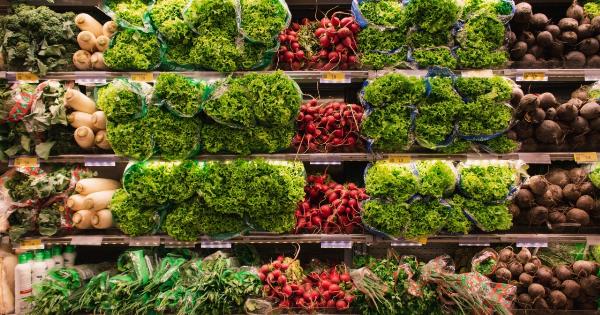Your fridge and freezer are filled with a wide variety of foods that can be used to create delicious and nutritious meals.
In this visual guide, we will explore 32 different foods that you might find in your fridge or freezer, providing you with information on their nutritional benefits and tips on how to use them in your cooking. Whether you’re a beginner in the kitchen or a seasoned chef, this guide will help you make the most of the ingredients you already have at hand.
Fruits
1. Apples:.
Apples are a versatile fruit that can be enjoyed on their own or used in a variety of recipes. They are a good source of fiber and are rich in antioxidants.
2. Berries:.
Whether it’s strawberries, blueberries, or raspberries, these little fruits are packed with vitamins, minerals, and antioxidants. Enjoy them fresh as a snack or add them to smoothies, yogurt, or desserts.
3. Lemons:.
Lemons are known for their high vitamin C content and their ability to add a bright and tangy flavor to dishes. They can be used in marinades, dressings, or squeezed over roasted veggies.
Vegetables
4. Spinach:.
Spinach is a leafy green that is rich in vitamins A, C, and K, as well as iron and calcium. Use it as a base for salads, sauté it as a side dish, or blend it into smoothies.
5. Carrots:.
Carrots are a great source of beta-carotene, fiber, and vitamins. Enjoy them raw as a snack, roast them with honey for a sweet side dish, or add them to soups and stews.
6. Broccoli:.
Broccoli is a cruciferous vegetable that is packed with vitamins, minerals, and fiber. Steam or roast it as a side dish, add it to stir-fries, or blend it into soups.
Protein
7. Chicken:.
Chicken is a lean source of protein that is versatile and can be used in a variety of recipes. Grill it, bake it, or sauté it for a delicious and healthy meal.
8. Salmon:.
Salmon is an excellent source of omega-3 fatty acids, which are beneficial for heart health. It can be grilled, baked, or pan-seared for a flavorful and nutritious meal.
9. Tofu:.
Tofu is a versatile plant-based protein that can be used in both savory and sweet dishes. It can be stir-fried, baked, or blended into smoothies or desserts.
Dairy Products
10. Milk:.
Milk is a staple in many households and is a good source of calcium, protein, and vitamins. Use it in smoothies, cereal, or baking recipes.
11. Greek Yogurt:.
Greek yogurt is a creamy and protein-packed dairy product that can be enjoyed on its own or used as a base for smoothies, dressings, or desserts.
12. Cheese:.
Cheese adds a rich and savory flavor to dishes and can be used in a variety of recipes. Sprinkle it over salads, melt it in sandwiches, or use it as a topping for pasta dishes.
Frozen Foods
13. Frozen Peas:.
Frozen peas are a convenient and nutritious addition to meals. They can be added to stir-fries, soups, or pasta dishes for a burst of color and flavor.
14. Frozen Mixed Vegetables:.
A blend of various vegetables, frozen mixed vegetables are a time-saving option for quick and easy meals. They can be stir-fried, steamed, or added to casseroles.
15. Frozen Berries:.
Frozen berries are perfect for making smoothies, desserts, or sauces. They retain their nutritional value and can add a burst of flavor to your dishes.
Baking Essentials
16. Flour:.
Flour is a versatile ingredient used in a wide range of baked goods. It can be used to make bread, cakes, cookies, and more.
17. Sugar:.
Sugar is a staple sweetener in many recipes, from cookies to cakes to sauces. There are various types of sugar, including granulated, brown, and powdered.
18. Baking Powder:.
Baking powder is a leavening agent that helps baked goods rise. It is essential for creating light and fluffy cakes, muffins, and pancakes.
Condiments and Sauces
19. Ketchup:.
Ketchup is a classic condiment that adds tanginess to burgers, fries, and sandwiches. It can also be used as a base for homemade barbecue sauces or marinades.
20. Mustard:.
Mustard offers a strong and tangy flavor that complements sandwiches, dressings, and marinades. There are various types of mustard, including yellow, Dijon, and whole grain.
21. Soy Sauce:.
Soy sauce is a staple in Asian cuisine and adds umami flavor to stir-fries, marinades, and sauces. It is available in regular and reduced-sodium options.
Snacks
22. Nuts:.
Nuts are a nutritious and filling snack packed with healthy fats, protein, and vitamins. Enjoy them on their own, sprinkle them over salads, or use them in baking.
23. Popcorn:.
Popcorn is a whole grain snack that can be enjoyed plain or flavored. Opt for air-popped or lightly salted varieties for a healthier alternative.
24. Crackers:.
Crackers are a versatile snack that can be enjoyed on their own or paired with dips, cheeses, or spreads. Choose whole grain options for added fiber.
Freezer Essentials
25. Ice Cream:.
Ice cream is a beloved frozen treat that comes in various flavors. Enjoy it on its own, make sundaes, or use it to make milkshakes and floats.
26. Frozen Pizza:.
Frozen pizza is a quick and easy meal option that can be customized with your favorite toppings. Look for options with whole grain crust and minimal added sugars.
27. Frozen Chicken Nuggets:.
Frozen chicken nuggets are a convenient option for a quick meal or snack. Pair them with a side of vegetables for a balanced meal.
Conclusion
Your fridge and freezer are treasure troves of ingredients that can be used to create delicious meals. Incorporating a variety of fruits, vegetables, proteins, dairy products, and other essentials can help you maintain a balanced and nutritious diet.
With this visual guide, you now have a better understanding of the foods that can be found in your fridge and freezer, and how to make the most of them in your cooking.



























